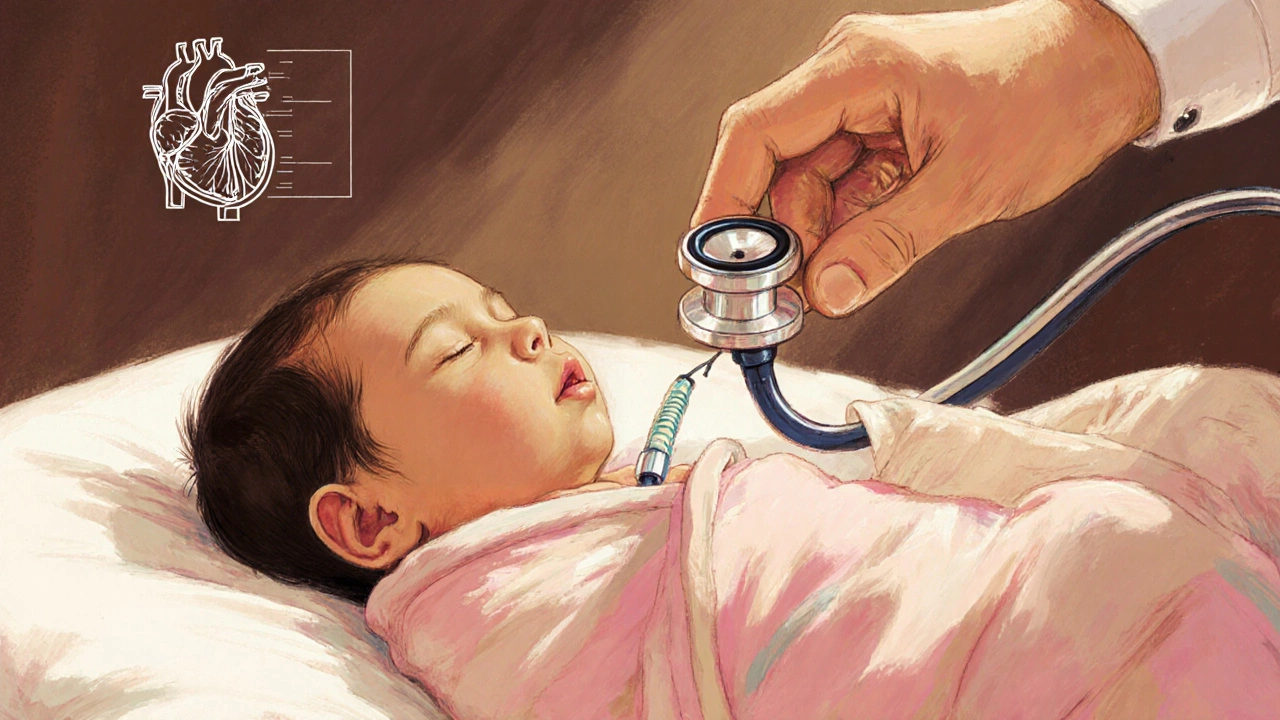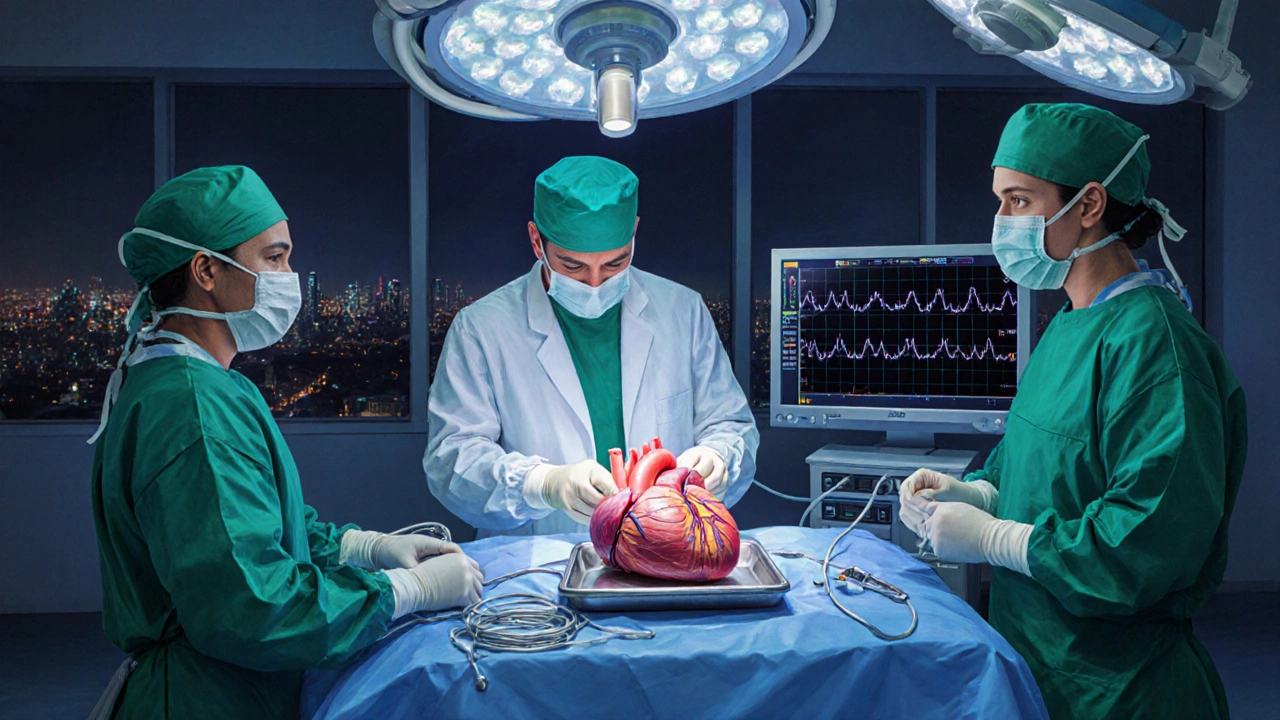Heart Surgery Difficulty Estimator
Compare the complexity of major heart surgeries based on key metrics.
Select a Heart Surgery
Operative Time (hours)
In-Hospital Mortality (%)
Recovery Period (weeks)
Quick Summary
- Heart transplantation, the Norwood procedure, and LVAD implantation top the list of toughest cardiac operations.
- Complex anatomy, need for cardiopulmonary bypass, and lifelong immunosuppression make these surgeries exceptionally demanding.
- Operative time can exceed 10 hours, with in‑hospital mortality ranging from 5% to 20% depending on the procedure.
- Only surgeons with specialized fellowship training and high‑volume centre experience can safely perform them.
- Choosing the right operation hinges on patient age, disease severity, and organ availability.
What Does “Hardest Surgery” Mean in Cardiology?
When we talk about the hardest heart surgery, we’re not just looking at how long the knife stays in the chest. It’s a mix of technical intricacy, physiological stress on the patient, and the logistical hurdles surrounding the operation. A surgery that requires micrometer‑level suturing, precise timing with a heart‑lung machine, and coordination with donor organ teams automatically climbs the difficulty ladder.
The Usual Suspects: Three Contenders
Cardiac surgeons often point to three procedures when asked which is toughest: heart transplantation, the Norwood procedure for hypoplastic left heart syndrome, and left ventricular assist device (LVAD) implantation. Below is a snapshot of each.
| Procedure | Avg. Operative Time | In‑Hospital Mortality | Typical Recovery | Key Challenge |
|---|---|---|---|---|
| Heart Transplantation | 6-10 hrs | 5-10% | 6-12 weeks | Donor matching & immunosuppression |
| Norwood Procedure | 8-12 hrs | 10-20% | 3-6 months | Re‑constructing newborn circulation |
| LVAD Implantation | 4-6 hrs | 5-8% | 4-8 weeks | Device integration & anticoagulation |
Heart Transplantation: The Ultimate Test
Heart transplantation is a surgical procedure that replaces a diseased heart with a healthy donor organ. First performed in the 1960s, it remains the gold standard for end‑stage heart failure. The operation starts with harvesting a donor heart, which must travel under strict temperature control to the recipient’s hospital. Surgeons then connect the donor heart to the patient’s great vessels while the patient is on cardiopulmonary bypass.
The difficulty lies in three fronts. First, donor hearts are scarce; matching blood type, size, and organ‑specific criteria often takes hours. Second, the entire procedure demands flawless timing: the heart can survive only about four to six hours outside the body. Third, post‑operative care involves lifelong immunosuppressive medication, which brings a host of complications like infections and kidney damage.
Norwood Procedure: Re‑Engineering a Newborn’s Heart
Norwood procedure is a complex congenital heart surgery performed on infants with hypoplastic left heart syndrome (HLHS). HLHS means the left side of the heart cannot pump effectively, so surgeons must create a new pathway that routes blood from the right ventricle to the systemic circulation.
This operation is usually the first of three staged surgeries. It involves attaching a reconstructed aortic arch, connecting a shunt from the pulmonary artery to the systemic circuit, and often incorporating a modified Blalock‑Taussig shunt or a right ventricle‑to‑pulmonary artery conduit. The tiniest margin of error can jeopardize an infant’s oxygen delivery.
Technical hurdles include operating on a chest that’s barely a few centimeters wide, delicate suture placement on fragile neonatal vessels, and managing the fragile balance of pulmonary and systemic blood flow. Even after a successful Norwood, the child will need two more surgeries before adolescence.

LVAD Implantation: Bridging the Gap
Left ventricular assist device (LVAD) implantation is a mechanical circulatory support method that helps a failing heart pump blood to the rest of the body. LVADs are used either as a bridge to transplant or as destination therapy for patients who cannot receive a donor heart.
During implantation, surgeons attach a pump to the apex of the left ventricle and connect an outflow graft to the ascending aorta. The device takes over most of the heart’s workload, allowing the native myocardium to rest. While the hardware itself is robust, the surgical phase is tricky: positioning the pump correctly, ensuring airtight cannula connections, and preventing air embolism are vital.
Post‑operative management adds another layer of complexity. Patients need strict anticoagulation to avoid pump thrombosis, and they must learn how to manage the external power source and monitoring console. A device malfunction can be life‑threatening, so surgeons and cardiology teams must be on standby 24/7.
Why These Surgeries Rank as the Hardest
All three procedures share common difficulty drivers:
- Technical precision: Micron‑level suturing on beating or non‑beating hearts demands extraordinary hand‑eye coordination.
- Physiological stress: Patients are often already in critical condition, so any misstep can trigger organ failure.
- Time constraints: Especially for transplantation, the “cold ischemic time” (time the donor organ stays cool) is strictly limited.
- Multidisciplinary coordination: Surgeons, anesthesiologists, perfusionists, transplant coordinators, and intensive‑care staff must function as a single unit.
- Long‑term management: Immunosuppression, anticoagulation, and device maintenance create ongoing risks.
Risks, Outcomes, and What Patients Can Expect
In‑hospital mortality remains the most stark metric. Heart transplants see about 5-10% death rates in high‑volume centres, while the Norwood procedure carries a higher 10-20% risk due to the fragility of newborns. LVAD implantation mortality is roughly 5-8%, often linked to bleeding or pump thrombosis.
Survivors, however, can enjoy dramatically improved quality of life. A transplanted heart can function for 10-20 years with proper care. Children who survive the Norwood often lead active lives after the final stage (Fontan completion). LVAD recipients report significant symptom relief and can return to daily activities, though they remain dependent on the device.
Complications include infection, organ rejection (for transplants), stroke (for LVADs), and growth‑related issues in infants undergoing the Norwood. Regular follow‑up with a heart‑failure team is essential.
How Surgeons Train for These High‑Stakes Operations
Becoming proficient takes more than a standard cardiothoracic residency. Surgeons typically complete a two‑year fellowship in adult or congenital cardiac surgery, followed by mentorship in high‑volume transplant or pediatric centres. Simulation labs now allow trainees to practice aortic arch reconstruction on 3‑D printed newborn hearts or rehearse donor‑organ retrieval with virtual reality.
Credentialing bodies require surgeons to log a minimum number of cases-often 50-100 heart transplants or 30 Norwood procedures-before they can operate independently. Ongoing peer review and outcome tracking help maintain standards.
Choosing the Right Path: Patient‑Centric Decision Making
When faced with end‑stage heart disease, patients and families weigh several factors:
- Age and overall health: Younger patients may be better candidates for transplantation, while older patients might opt for LVAD as destination therapy.
- Disease specifics: Congenital anomalies like HLHS demand the Norwood as the only viable early‑life solution.
- Donor availability: Waiting times for a heart can stretch months to years; LVAD can buy time.
- Center experience: Outcomes improve dramatically at hospitals performing >30 of the chosen procedure annually.
Open dialogue with a multidisciplinary team-cardiologist, surgeon, transplant coordinator, and social worker-helps align expectations and choose the safest, most effective route.
Frequently Asked Questions
What is the most complex heart surgery performed today?
Heart transplantation is generally considered the most complex due to donor matching, limited organ time, and lifelong immunosuppression, though the Norwood procedure and LVAD implantation are close contenders.
How long does a heart transplant surgery take?
The operative time ranges from six to ten hours, depending on donor heart condition and recipient anatomy.
What are the survival rates after the Norwood procedure?
Survival to hospital discharge is about 80-90% in experienced centers; long‑term survival past the Fontan completion reaches 70% at ten years.
Can an LVAD be a permanent solution?
Yes, when a patient is ineligible for transplant, an LVAD can serve as destination therapy, offering years of improved quality of life.
What factors influence the choice between transplant and LVAD?
Key factors include age, comorbidities, donor heart availability, and patient willingness to undergo lifelong immunosuppression versus managing a mechanical device.



